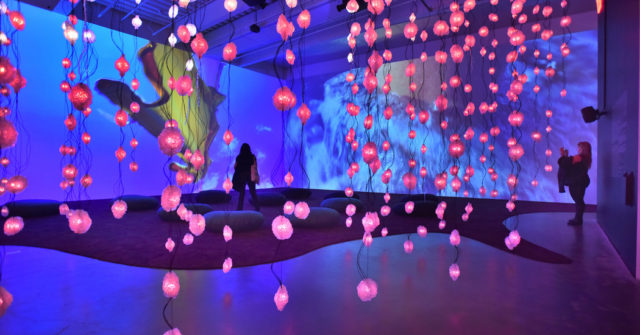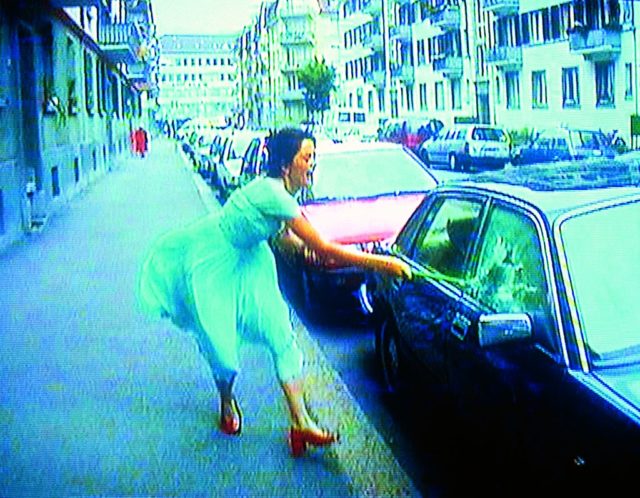
Pipilotti Rist Pixel Forest. Image: New York Times
Feminism isn’t easy to pin down. It’s a social movement that shares a common goal: to define, establish, and achieve political, economic, and social rights for women. It’s famously defined by waves (first, second and third) that only a few of us can fully explain without referencing Wikipedia.
For me, feminism is characterized less by the social movement it describes, than by woman who chose for themselves what they like, what they want, and who they are. It’s simple, and that’s part of why I like it. It’s inclusive, and it can be fun, pleasurable and charming—all qualities of the most infectious and influential kinds of movements.
As it happens, this is exactly the strength of “Pipilotti Rist: Pixel Forest”, the New Museum’s 30 retrospective of the artist’s videos curated by Massimiliano Gioni. Rist’s work, as seen through three floors of immersive installations, viewing carpets, beds and video cubbies projects a brighter and more buoyant brand of feminism than almost any I’ve seen. It makes her art and the movement as a whole more accessible, and creates an almost wholly successful show.
The exhibition resembles a river. Video flows through the museum like water— fluid, undulating, and inexplicably magnetic. Often, the slow moving videos featuring figures, water and manipulated sound read as though they were a direct projection of the artist’s mind. That’s no easy feat, particularly in the field of video art, which perhaps requires more rigor in installation than any other medium. In fact, the exhibition, which is arranged roughly chronologically, makes clear that there may be no living artist with a better grasp on the relationship between video and presentation than Rist.

Pipilotti Rist, 2nd floor at the New Museum. Installation view. Image: New York Times.
From the outset, Rist presents her vision of sexuality, desire and the body. A selection of single channel videos created in the early eighties, presented in a row of futuristic triangular-shaped viewing booths feel vaguely seedy. To view the videos a person has to step on a stool below the booth and duck their head into a hole at the bottom of the viewer. Inside the booths, I saw a video of a naked man dancing in a park, Sexie Sad 1 (1987), a sped up, chipmunk-sounding recital of the song, I’m Not The Girl Who Misses Much (1986), and Rist playing air guitar while lip-syncing to You Called Me Jacky (1990). Each has a quirky, playful quality that makes the awkward business of sticking your head in a box to view the videos feel just fine.
And that’s arguably Rist’s greatest skill—creating videos in which female desire and anger feel good—even fun. Take Rist’s best known piece, Ever Is Over All, (1997) which pictures a dreamlike sequence in which a woman in a blue dress joyfully smashes the windows of cars as she walks down the street. Rist’s world is pure fantasy and without consequence—a female police officer walks by and gives her a nod of approval. It’s pleasing to see this anger, even liberating, though I’m not sure I recognized it as such when I first viewed it. I was too busy feeling good to notice what was missing—the fear and anxiety a woman’s anger often evokes.

Pipilotti Rist, “Ever if Over All” Image still.
The disarming charm of these videos stays with a viewer throughout the show. In Sip My Ocean (1996) a two channel video, we watch kaleidoscopic images of the sky, Rist swimming underwater, and coral melt together as if fucking. Rist’s high pitched voice awkwardly croons out Wicked Game adding a layer of amateur sex appeal to an otherwise slick video. It would be a stretch to call Rist’s work democratic or mass media friendly, but in the art world, short of William Wegman, she’s about as close as we get. (Pop superstar Beyonce did, after all, allegedly draw inspiration/copy from “Ever Is Over All” for her 2016 music video Hold Up.)
It’s no surprise, then, that the artist has influenced seemingly countless art students and professionals a like. It’s hard not to look at the work of Petra Cortright, who similarly casts herself in scored videos, or Marilyn Minter whose slowed down video of a woman’s feet in high heels violently slashing silver mud all recall Rist’s videos. There’s a shared sensibility and urgency to the expression.
Pixel Forest, 2016 at the New Museum. Image: Paddy Johnson
The pinnacle moment of Rist’s affinity for dazzling effects and female sexuality takes place on third floor, where she literally explodes her video into a forest hanging oyster-shaped crystal lights in Pixelwald (Pixel Forest) (2016). Within each pod lives a pixel from her video, that constantly changes with the moving image. It doesn’t take an art degree to figure out that those oysters are vaginas, but if you weren’t sure the videos in the forest’s clearing seem to support that point. In Mercy Garden (2014), and Worry Will Vanish Horizon (2014) we see underwater shots of a naked man, a woman drawing her fingers along the beach, a hand on barb wire, and even the inside of the body. Of course, its up to the viewer how much stock they want to put in the symbolism, but I took her overstimulation of a viewer’s senses to be a metaphor for the sensation of great sex.
Naturally, by the time we reach the end of the exhibition, the fourth floor, Rist has viewers actually laid out on beds so they can watch videos play directly over their heads for 4th Floor To Mildness, (2016). The screens are amorphous, and the video, much like many others takes place mostly underwater.
While watching, a friend turned to me to complain that there weren’t enough dicks in this one. After having been through the third floor I was quite satisfied with the number of underwater dicks I’d seen, so I’m not sure I needed any more. They showed up eventually, in between shots of murky water and shriveled fingers, but the tempo was a bit more relaxed. “Is this supposed to be what happens with age?” I wondered, knowing that at this point I’d watched over 30 years of work. “You care less about sex?” Sure, but then after three floors of completely unself-conscious expression of desire, angst and anger, who wouldn’t be tired? I, for one, needed a nap.


Comments on this entry are closed.